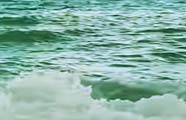All About Bass Fishing - Guide To Fishing In The Wind
By Rick Seaman and Dan Westfall
 Wind can have a significant impact on bass. At times it can tell you exactly where to find the bass. Other times it can add confusion to the already complex puzzle. While it’s important to observe the direction of the wind while you’re fishing, it can be more important to know which way the wind was blowing for the last 24 hours or more.
Wind can have a significant impact on bass. At times it can tell you exactly where to find the bass. Other times it can add confusion to the already complex puzzle. While it’s important to observe the direction of the wind while you’re fishing, it can be more important to know which way the wind was blowing for the last 24 hours or more.
3 Most Important Factors About Wind
- Wind moves surface plankton and oxygenates water in the direction it’s blowing.
- Baitfish follow the plankton, bass follow the baitfish and typically move shallower.
- Excess wind can stir up mud and silt, causing bass to avoid these areas.
3 Most Effective Fishing Methods & Lures
- In clean water try buzzbaits or other noisy/active top water baits first.
- Then try crankbaits and spinnerbaits – fast in clean water, slower in dirty water.
- Use jigs and spoons in mid-range depths below the active baitfish.
Important details for fishing in windy conditions
Positive Impact
 Plankton are at the bottom of the food chain in freshwater lakes. It is a primary food source for shad and other baitfish which reside in the lake. Plankton suspends in the water near the surface to absorb oxygen, sunlight and nutrients from the water. Blowing wind moves the waters surface, including the plankton, in the direction of the wind. As waves are created, the splashing and turbulence caused by the wind mixes oxygen into the water. The longer the wind blows in a specific direction, the greater the impact on the plankton, baitfish and ultimately the bass. This condition has the greatest impact on bass during summer, but should be considered anytime the bass are shallow or at medium depths.
Plankton are at the bottom of the food chain in freshwater lakes. It is a primary food source for shad and other baitfish which reside in the lake. Plankton suspends in the water near the surface to absorb oxygen, sunlight and nutrients from the water. Blowing wind moves the waters surface, including the plankton, in the direction of the wind. As waves are created, the splashing and turbulence caused by the wind mixes oxygen into the water. The longer the wind blows in a specific direction, the greater the impact on the plankton, baitfish and ultimately the bass. This condition has the greatest impact on bass during summer, but should be considered anytime the bass are shallow or at medium depths.
How to take advantage of these conditions
If the wind is blowing from the southwest, it will be blowing into the northeast shorelines of the lake. Choose areas of the lake that fulfill seasonal patterns, that are positioned on the northeast shorelines and concentrate your effort there. If possible, match the baitfish colors with your lure. Start with noisy, attention-getting top water baits. Buzzbaits are ideal because they make enough noise to be noticed in splashing, noisy water. Other noisy top water baits like poppers, chuggers and prop baits can work as well. If the bass won’t take lures from the surface, try crankbaits or spinnerbaits suited for the cover you are fishing. If bass are holding in deeper water below the baitfish, use jigs or spoons to mimic injured baitfish. With all the activity of the baitfish, the bass are likely to be on alert and react to anything that resembles food.
Negative impact
Excess wind can stir up silt, sediment and mud – particularly when lakes are at low-water levels where a significant amount of silt covers the bottom in shallow water. The silt interferes with all forms of life in the lake. Fish and baitfish gills can become clogged with silt, making it difficult to breathe. All forms of life reduce their activity to minimal in order to reduce their requirement for oxygen. Depending on the severity of the silt or dust particles in the water, bass may resort to “survival mode”, limiting motion to bare minimum. During these conditions they will not chase food and rely more heavily on their ability to ambush easy prey when it gets too close to pass up.
AA Bass Fishing Knowledge Base
- Bass Fishing Overview
- Life Cycle Of Bass
- Seasonal Bass Migration
- Bass Migration - Mid to Late Winter
- Bass Migration - Spring
- Bass Migration - Early Summer
- Bass Migration - Late Summer
- Bass Migration - Fall
- Bass Migration - Early Winter
- Fishing For Bass
- It's Now WHAT You Throw, It's WHERE
- Research The Fishery Before You Go
- Review Contour Maps
- Types Of Cover Used By Bass
- Bass Fishing In Grass Beds
- Bass Fishing In Wood & Timber
- Bass Fishing In Brush & Vegetation
- Establishing Patterns
- Learn To Recognize Bites
- Review Lunar Tables
- Choose The Right Lures
- Find Bass Based On Conditions
- Conditions - Fold Fronts
- Conditions - Wind
- Conditions - Cloudy Days
- Conditions - Fishing In The Rain
- Conditions - Water Clarity
- Conditions - Rising Water
- Conditions - Falling Water
- Conditions - Fishing At Night
- Equipment & Tackle
- Equipment - Fishing Rods
- Equipment - Fishing Reels
- Equipment - Fishing Line
- Equipment - Fishing Lures
- Fishing With Live Bait
- Shallow Water Techniques, 0 -10'
- Shallow Fishing - Spinnerbaits
- Shallow Fishing - Crankbaits
- Shallow Fishing - Top Water
- Shallow Fishing - Pitching & Flipping
- Shallow Fishing - Artificial Worms
- Shallow Fishing - Jigs
- Shallow Fishing - Flukes
- Shallow Fishing - Stick Worms
- Shallow Fishing - Swimbaits
- Fishing Mid Range Depths, 10' - 25'
- Mid Depth - Spinnerbaits
- Mid Depth - Deep Diving Crankbaits
- Mid Depth - Artificial Worms
- Mid Depth - Jigs
- Mid Depth - Swimbaits
- Fishing Deep Water & Structure
- Fishing Deep Water - Jigs
- Fishing Deep Water - Jigging Spoons
- Fishing Deep Water - Artificial Worms
- Planning Your Attack
- Bass Fishing Questions & Answers
- Conservation - Protect The Fishery
Bass information by state
101624
Fishing Information



